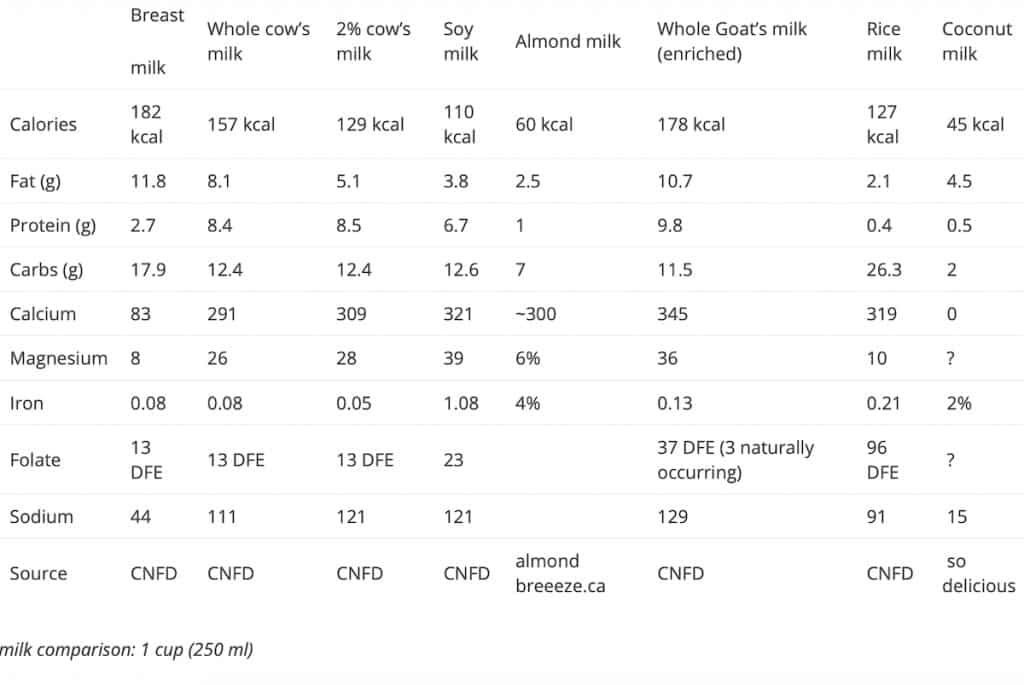We get a lot of questions about milk for babies… like when should I be introducing baby to milk, or how much milk should they drink?
Your baby definitely needs milk, but the type of milk is key, depending on the baby’s age.
Babies’ stomachs are small, and they grow fast. Everything that enters their mouths needs to contribute to their growth. The reason milk for babies is so important is because it provides these nutritional benefits to help them grow:
- fat and calories
- minerals
- vitamins
- some protein
babies only need one milk at a time
If you’re providing breast milk for baby, your milk also contains additional benefits like immune antibodies, probiotics, and prebiotics. This milk is so good for your baby, there’s really no need to introduce baby to any other kind of milk. Similarly, formula is made specifically for your baby’s nutritional needs, so there’s no need to supplement formula with other kinds of milk.
However, that doesn’t mean you CAN’T supplement with cow’s milk or other milks, once your baby is old enough.
Here are the recommendations for the type of milk for each age range:
0-6 months: At this age you baby can happily suck away at the breast or bottle (containing formula or breastmilk). Nipples only. No cow is needed.
6-9 months: Still no cow’s milk or alternatives yet but at this time baby should be starting to eat solids foods.
9-12 months: At this age you can feel free to substitute whole cow’s milk for breastmilk or formula BUT only if baby is regularly eating iron-rich foods at least two times a day. Some iron-rich foods include meat, eggs, and iron-fortified infant cereal.
12-24 months: Whole cow’s milk can be freely substituted for breastmilk or formula. Hold off on the other milk alternatives for now.
24 months +: 2% milk, goat’s milk or unsweetened fortified soy beverage can be substituted for whole cow’s milk. Hold off on the other milk alternatives for now.
a data-based guide to introducing milk to baby
Let’s take a look at why this progression is recommended. If you’re interested in data, here’s a nutritional comparison of various milks and alternatives:

If you’re not interested in all that data, here are the main considerations when introducing baby to milk:
- Babies were designed to grow optimally on breastmilk. So when considering milk for baby, it’s very important to make any transition slowly. Formulas replicate the breastmilk optimization as best as possible, so the same goes for the transition from baby formula to other foods.
- Milk for babies is important because they’re accustomed to getting their calories in liquid form. You may not realize the significant contribution milk makes to the caloric intake of a baby. At 12 months, a child gets approximately 35-40% of their calories from milk. So it’s recommended that a child over 12 months continue drinking between 2-3 cups of milk. This is 314-461 calories.
- There are problematic differences between breastmilk and other milk for baby. Babies’ bodies have not yet developed to the point that they can regulate things like increased levels of sodium. Because of this, introducing baby to milk too early can be dangerous! If you look at the sodium levels, you’ll see that breastmilk is relatively low in sodium. As the body develops, the kidneys will be able to refilter sodium, but in early infancy we need to be careful about not feeding them food that they’re not yet ready to handle.
why not soy milk or goat’s milk or rice milk or…?
Many of my clients ask about other kinds of milk for baby, wondering when it’s okay to introduce these milk alternatives. Unfortunately, none of those milks alternatives are appropriate for children under two years of age (unless directed under medical or dietetic supervision). If a child is no longer breastfeeding and is unable to drink whole cow’s milk, formula should be given.
- Goat’s milk is naturally low in folate. If goat’s milk is offered to children it should be whole fat goat’s milk fortified with folic acid (synthetic folate).
- Soy beverage is low in fat and slightly low in protein.
- Rice, almond, coconut, hemp, and pretty much all other milk alternatives are low in protein, fat, and calories.
There have been cases where infants have developed nutrient deficiencies when they’ve been fed an inappropriate milk alternative without supervision by a nutrition professional.
- This 11 month old baby in Spain developed scurvy, a severe form of Vitamin C deficiency, after consuming almond milk almost exclusively from two months old.
- This 22 month old baby was found severely lacking in protein and calories after being weaned from breastmilk to a rice beverage at 13 months.
For the rest of the family, an alternative milk may be fine! We all have unique nutritional needs, which is why I created this guide to deciding which milk or alternative is best for YOUR unique needs
why I always recommend whole milk for babies
In the 70s, childhood obesity was on the rise. With good intentions to reduce this trend, some physicians started to recommend that infants be given skim (fat-free) milk. However, this study shows babies fed skim milk deplete their fat stores to maintain growth in length. Children need the fat for brain development and the additional calories fat provides for growth.
how much milk should baby drink?
For the most part, I tell parents to follow Ellyn Satter’s division of responsibility. According to this plan, caregivers decide what, when, and where food is offered, but the child decides whether they’ll eat and how much they’ll eat. I’ll emphasize that last part: you, the caregiver, don’t set a minimum or maximum amount of food.
Milk, however, can be the exception. I don’t recommend forcing children to drink milk if they don’t like it. For those children, you’ll need to be more creative in offering dairy or alternatives in a way they’ll accept (example: cook oatmeal in milk instead of water). Alternatively, there are children who will happily guzzle milk all day long, to the point where they won’t eat much else. This means a milk restriction will be needed for those children.
Too much of a good thing does exist! Children who drink more than 3 cups (750 ml or 24 oz) of milk a day are at higher risk of developing an iron deficiency. This is because:
- milk is a low source of iron
- calcium in milk can inhibit iron absorption
- high milk intake can lower intakes of other foods (some of which will be the high iron sources or sources of Vitamin C, which helps increase iron absorption)
The bottom line? Older babies and toddlers should be drinking between 2 to 3 cup (500-750 ml) each day.
conclusion – is milk for babies?
Historically, this question would not have popped into anyone’s minds. In today’s Western culture, most mothers wean a lot earlier than our ancestors would have.
Without wanting to sound too alarmist, the type and amount of beverages a young child drinks is rather important to their growth and development. If you are concerned about your child’s intake please seek out the expertise of a Registered Dietitian! We can help you develop a feeding plan that will work with your family’s eating preferences (eg: veganism), your child’s food tolerances/intolerances, and your child’s food preferences…..all while meeting his or her nutritional needs!






